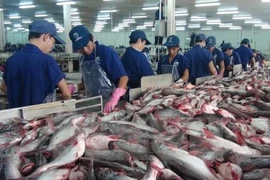The US has imposed high anti-dumping tariffs on Vietnamese tra exporterssince 2014. Earlier this year, it also imposed a new requirement thatforeign exporters demonstrate their food safety control system is equivalent toAmerican regulations, creating a new hurdle for Vietnamese companies.
Although prices in the US market are high and stable, the difficulties arespurring Vietnamese tra companies to seek new customers in Mexico,Canada and China.
According to the Vietnam Association of Seafood Exporters and Producers(VASEP), there are about 14 tra fish enterprises exporting to the USmarket. However, due to the high anti-dumping tax, only three companies -- VinhHoan Corporation, Hung Vuong JSC and Bien Dong Seafood Company Ltd -- aresignificant exporters to this market, while the remaining 11 ship smallquantities.
As the role of the US as an importer of tra fish declines, Vietnamesecompanies are working to increase demand for tra internationally. Inthe long run, the businesses say they need to develop branding and improve theimage of tra fish in the world market.
About three years ago, Truong Giang Fisheries Joint Stock Company in thesouthern province of Dong Thap tried to export some containers of catfish tothe US, but the high anti-dumping tax made the effort unprofitable. The companyhas no intention to try to export tra fish to the US again. Insteadit is seeking other markets.
Hang Van, Deputy Director of Truong Giang Company, said that in the past fewyears, when the US imposed a high anti-dumping duty, many businesses have movedtheir exports to other markets.
“Notably, in South Asia, Pakistan and India are quite potential markets forVietnamese pangasius,” Văn said. “Pakistan currently accounts for about 10 percentof the company’s exports.”
According to Van, tra fish exporters could focus on promoting exportsto the Indian market, the world’s second-largest in terms of population. TheIndian consumers have initially accepted tra fish products.
"However, the import tax of tra fish in India is still too high,up to 70 – 80 percent, so that importers do not dare to import much,” said Van.“In the coming time, if the two governments enhance trade cooperation andreduce import taxes, Vietnam’s tra consumption market will be very large.”
Song Tien Seafood JSC and Ngoc Xuan Seafood JSC in the southern province of TienGiang are also seeking ways to export their products to non-US markets,including the EU, China and Middle East.
Nguyen Thi Anh, the head of both businesses mentioned above, said her companiesthis year accessed a number of new markets, such as the Middle East, SouthAmerica and China.
“As for the EU market, it has been still the strategic market of businesses formany years, accounting for about 60 – 70 percent of the total exports,” said Anh.“To keep the stable volume of customers in this market, the company has focusedon investment, ensuring product quality from raw materials to processing.”
Therefore, although the company does not export tra fish to the US,its export turnover is stable and growing, Anh added.
Insiders also said that Vinh Hoan - one of the three leading Vietnamesecompanies exporting tra fish to the US - are focusing on exploitingnewly-emerged markets.
Nguyen Ngo Vi Tam, General Director of Vinh Hoan Corporation, said the companyhad recently developed new markets. It is especially focusing on value-addedproducts.
Tam said the company had installed a production line of grilled tra fishproducts marinated in teriyaki, a Japanese cooking technique, for export toJapan. After years of development efforts, Japanese consumers have startedaccepting freshwater fish products.
“If businesses focus on product quality control, this will be a potentialmarket for Vietnam’s tra industry in Asia, just after China,” said Tam.
Honorary President of VASEP Nguyen Thi Hong Minh said there were still manyopportunities to develop the tra fish industry and change theworldview of Vietnamese tra fish. First of all, he said, Vietnamneeds a national-level tra fish product.
Minh proposed to make a line of tra fish fillet products that wouldbe based on a common standard system. Meanwhile, the processing enterprises andexporters would jointly develop markets and branding.
"The main product must be fillet because it accounts for 80 percent of Vietnam’sexport of tra fish. In addition, relevant agencies must also supportthe development of this product line, which needs to have logos and a brandname as well,” said Minh.-VNA





























